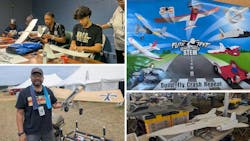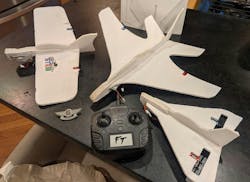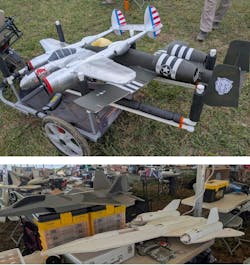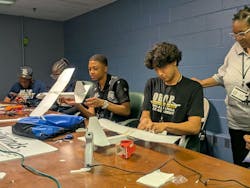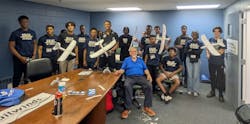Embracing the Crash: Fun-Forward STEM Education with Model Airplanes
What you’ll learn:
- Flite Test, the festival’s sponsor, offers kits to build anything from simple trainer aircraft to multi-engine warbird replicas from inexpensive foam-backed posterboard.
- Simple materials and sophisticated electronics make it easy for enthusiasts to graduate from building kits to designing their own model aircraft.
- The festival’s workshop tents are filled with kids as young as six years old, who are building their first models working alongside seasoned aerospace engineers.
- Flite Test also uses their models as the heart of an extraordinary STEM education program based on a “fun-forward” approach to introducing kids to new skills and technologies.
The crowd stands shoulder to shoulder at the edge of the grass airstrip, poised with their model aircraft in one hand and a controller in the other as the PA system crackles to life, with a 10-second countdown to launch. On command, hundreds of electric motors whir to life and an angry swarm of tiny planes fill the sky above the field as they begin to systematically try to knock each other out of the sky.
Amidst the mayhem, a delta-shaped stunt plane manages to shred the tail of a replica of a WWI biplane and the first casualty of the event spirals into the ground. Meanwhile, the announcer struggles to narrate the chaos of a dozen or more simultaneous dogfights occurring overhead. A few minutes later, a handful of intact planes remain aloft and prepare to land while 200 other pilots begin to retrieve the remains of their wrecked aircraft, many of which will be taped, glued, and patched back together in time for the evening air combat event.
A Woodstock for Airplane Nerds
These daily dogfights were only one of many activities at Flite Fest 2025, a curious event that brings nearly 6,000 model airplane enthusiasts to Malvern, Ohio for a weekend of fun, flying, and fellowship. But Flite Fest is about much more than model airplanes.
It’s a community of creators who use advances in materials and electronics to push the limits of their own creativity and share their knowledge with others. As a result, the festival’s three huge workshop tents are filled with kids as young as six years old (Fig. 1). They’re building their first models working alongside seasoned aerospace engineers who are putting the final touches on their latest designs.
A Miracle Made in the USA
Now celebrating its 11th anniversary, Flight Fest is the brainchild of Josh and Jen Bixler, the founders of Flite Test, a company which manufactures model airplane kits a few miles down the road from where the festival is happening. Besides creating employment opportunities in rural Ohio, manufacturing locally allows Bixler to rapidly bring new ideas into production, maintain high product quality, and discourage IP theft by would-be copycats.
While most of the motors and electronics come from overseas, they’re in the process of onshoring some of these components. Their EZ ID drone identification module and the latest generation of their Aura gyro platform are already manufactured locally, with plans to expand their line of USA-made electronics in the near future (more about this in a follow-up article, stay tuned…).
The business is driven by Bixler’s love of aviation and his mission to provide kids and families with engaging products that encourage them to play, learn, and grow together.
To keep things simple, safe, and affordable, all of Flite Test’s powered designs are built from laser-cut pieces of foam-backed poster board and use electric motors (Fig. 2). This makes it easy to build and repair them using little more than a razor knife, hot glue, and packing tape. Because Flite Test planes can be quickly repaired, they encourage young builders to experiment, try new things, and in Bixler’s words, “embrace the crash,” treating even undesired outcomes as learning experiences rather than failures.
The company uses the same design philosophy to develop robust, affordable, and easy-to-use propulsion and control systems for their products. For kids getting started in the hobby, they offer a complete R/C propulsion and control system.
Priced at under $40, the kit includes a pair of motors and props, a battery, a receiver/controller, and a two-channel R/C transmitter that can be used to power any one of their EZ Flyer series aircraft. This includes an adorable radio-controlled “Battle Blimp,” a self-propelled Mylar party balloon that kids of all ages can sail majestically across the living room, race through airborne obstacle courses, or use to terrorize unwary pets.
Once hooked, entry-level hobbyists can begin to develop their construction and flying skills with any one of several rugged, affordable trainer aircraft, before graduating to higher-performing sport and acrobatic planes. With the basics mastered, they can graduate to more complex projects, including drones, large-scale replicas of WWII fighters and bombers, and a 6-foot long F-18 Super Hornet (Fig. 3).
Flite Test also encourages its customers to experiment with their own designs by making all of its materials, components, and electronics available on an “a la carte” basis. The company even offers free plans for many of its basic kits, which budget-minded builders can cut out themselves from raw foam board.
One of the most interesting DIY birds I spotted in the build tents was a large replica of a Lancaster bomber, which helped Britain win the day during WWII. As the video below attests, the young builder used a CAD program to design the foam-board pieces and 3D-printed components he’d need to assemble the four-engine behemoth.
Fun-Forward STEM Education
As part of its mission, Flite Test is creating the tools for an educational revolution based on a “fun-forward” approach to introducing kids to new skills and technologies, while helping them become fearless, enthusiastic learners. They also make it fun and easy to learn the STEM skills they’ll need to step into careers in engineering and science or simply enhance their technical literacy.
Several of their most popular gliders, entry-level electric planes, and drones are available at a discount in multi-unit “starter kits.” The kits include a curriculum, lesson plans, games, and other resources to give kids a hands-on introduction to science and technology. Many of the curricula also teach design skills by modifying their models and then testing their performance.
As a part of its commitment to STEM education, Flite Test ran several free training sessions at Flite Fest. Educators got hands-on experience with building model airplanes and how the teaching materials could be used together.
From Theory to Practice
A week after returning from Flite Fest, I got to put some of these tools to work as part of a weeklong aviation program for teens that was being run by my local flying club in cooperation with the Organization of Black Airline Professionals (OBAP). Because building Flite Test’s Wonder Glider kit involves forming a reinforced fuselage, a rudimentary wing spar, and forming curved airfoil wings from sheets of flat poster board, it was a great way to introduce our campers to many aviation-related concepts and skills (Fig. 4).
Each group got their own glider, and we worked through the assembly steps outlined in the instructional video. Since this was some of the campers’ first building projects, we all got to experience our share of mistakes, which eventually became learning opportunities. The kids quickly figured out that any parts they had accidentally damaged or put in the wrong place could be fixed with a little cutting, hot glue, and packing tape.
And when one group tried to fly their glider before it was ready, they got a quick lesson in why adjusting the craft’s center of gravity is critical to a successful flight. It was a thrill watching the kids test their gliders and learn how properly positioning a small counterweight could enable them to make smooth flights of 100 feet or more (Fig. 5).
But my happiest moment of the day was when some of the kids, who lingered after class, experimenting with ideas they’d come up with on their own to modify their plane to make it fly even better—or simply look cooler. By the time we parted, it was clear that those simple model kits had helped me introduce several future aviators and engineers to the world of flight.
About the Author
Lee Goldberg
Contributing Editor
Lee Goldberg is a self-identified “Recovering Engineer,” Maker/Hacker, Green-Tech Maven, Aviator, Gadfly, and Geek Dad. He spent the first 18 years of his career helping design microprocessors, embedded systems, renewable energy applications, and the occasional interplanetary spacecraft. After trading his ‘scope and soldering iron for a keyboard and a second career as a tech journalist, he’s spent the next two decades at several print and online engineering publications.
Lee’s current focus is power electronics, especially the technologies involved with energy efficiency, energy management, and renewable energy. This dovetails with his coverage of sustainable technologies and various environmental and social issues within the engineering community that he began in 1996. Lee also covers 3D printers, open-source hardware, and other Maker/Hacker technologies.
Lee holds a BSEE in Electrical Engineering from Thomas Edison College, and participated in a colloquium on technology, society, and the environment at Goddard College’s Institute for Social Ecology. His book, “Green Electronics/Green Bottom Line - A Commonsense Guide To Environmentally Responsible Engineering and Management,” was published by Newnes Press.
Lee, his wife Catherine, and his daughter Anwyn currently reside in the outskirts of Princeton N.J., where they masquerade as a typical suburban family.
Lee also writes the regular PowerBites series.
